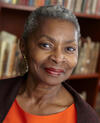In The News: Oral History Research Center
Mark Bauerlein has become disillusioned with the political and academic ideal sometimes called “the free marketplace of ideas,” especially in America’s institutions of higher education.

Claytee White, director of the Oral History Research Center at UNLV Libraries joined us to talk about two important women in particular - Hattie Canty and Ruby Duncan, and the contributions they've made to U.S. history.
70 years ago, iconic Black musicians like Sammy Davis Jr. and Harry Belafonte might have graced the stage at Vegas casinos — but wouldn’t be allowed to stay on-site, or walk through the front door (though many pushed back).

Storming Ceasers Palace tells the inspirational story of a group of determined mothers from West Las Vegas. Mothers who became advocates for their children and for welfare rights.

Drive to the 900 block of West Bonanza Road in Las Vegas' Historic Westside, and all that’s left of the Moulin Rouge Hotel & Casino is a giant vacant lot and a series of peeling murals on an adjacent building. But this spot on the National Register of Historic Places is a portal into the city’s Black history.

Drive to the 900 block of West Bonanza Road in Las Vegas' Historic Westside, and all that’s left of the Moulin Rouge Hotel & Casino is a giant vacant lot and a series of peeling murals on an adjacent building. But this spot on the National Register of Historic Places is a portal into the city’s Black history.

African Fashion Show: The fashion industry owes so much to Black culture. Many of the trends we see today, and that were popularized in the ’70s, ’80s and ’90s, can be traced back to the Black community. In recognition of that influence, Las Vegas’ chapter of the National Coalition of 100 Black Women Inc. will host its fifth-annual African Fashion Show, educating attendees on the history of Black fashion and the importance of the African American image. Claytee White, director of UNLV’s Oral History Center, will guide the conversation as a guest speaker, joining designers, fashion boutique owners and market vendors in a celebration of Black heritage.

Las Vegas has no shortage of great entertainers no matter their racial background, but turn back the clock 50 or 60 years ago, those entertainers could not stay at the casinos or hotels they performed at. Instead, they stayed at the Historic Harrison Guest House.

This Black History Month, News 3 is highlighting and honoring pioneers who have shaped and changed what’s possible in Nevada. One of those people is Sarann Knight-Preddy. Knight-Preddy was the first Black person to receive a gaming license in the state. She died in 2014, but her legacy lives on in merit of ways.

Anna Bailey, the first Black showgirl on the Las Vegas strip, was in huge demand in the 1960s, but she couldn't even walk in the front doors at some of the same casinos where she performed. The Moulin Rouge, which opened in May of 1955, was the first casino Bailey worked when she moved to Las Vegas from New York. It was built in the majority Black West Side of Las Vegas so the hotel and casino could be integrated and it was the first racially integrated casino-resort in the country.

Anna Bailey, the first Black showgirl on the Las Vegas strip, was in huge demand in the 1960s, but she couldn't even walk in the front doors at some of the same casinos where she performed. The Moulin Rouge, which opened in May of 1955, was the first casino Bailey worked when she moved to Las Vegas from New York. It was built in the majority Black West Side of Las Vegas so the hotel and casino could be integrated and it was the first racially integrated casino-resort in the country.

It was a great migration and a time when the Basic Magnesium plant in Henderson became one of the earliest working hubs for African American workers. Claytee White, director of oral research history at UNLV said when America entered World War II, the United States was trying to catch up on new technology.

